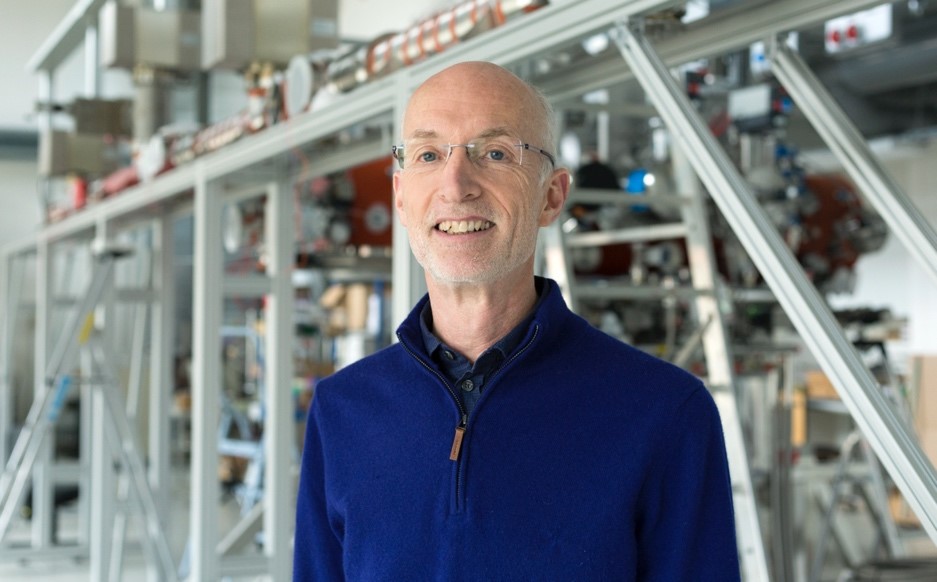Time: 15:30, Oct. 17 (Thursday), 2024
Venue: Rm. S106, Teaching Building of UCAS Zhong-Guan-Cun Campus
Speaker: Stuart S. P. Parkin (Max Planck Inst. for Microstructure Physics)
Abstract:
Spintronics allows for advanced memory and storage technologies that go beyond today’s charge-based devices. Of especial interest is Magnetic Racetrack Memory (RTM) that is a unique memory-storage device that relies on the current driven motion of domain walls along magnetic conduits. Racetrack Memory has evolved in several distinct stages, that we have dubbed version 1.0-4.0. In version 4.0 we have shown that chiral domain walls can be driven at speeds exceeding 1 km/s in synthetic antiferromagnetic racetracks by spin currents generated via the spin Hall effect in proximal metallic layers[1]. The scaling of 2D racetrack conduits to sub 80 nm wide dimensions is presented and the use of integrated anomalous Hall read sensors that allow for the detection of domain walls with ~10 nm spatial resolution is described [2]. We discuss several schemes for building prototype 3D racetracks. In one case freestanding membranes composed of atomically engineered thin film heterostructures that form the racetrack are formed on a sacrificial water-soluble sacrificial release layer. The freestanding membranes are transferred onto protrusions that have been pre-patterned on sapphire wafers to create 3D racetracks [3]. In a second approach we fabricate 3D chiral magnetic racetracks via a novel state-of-the-art multi-photon super-resolution lithography system. [4]. We show how the interplay between the geometrical chirality and the spin chirality of the individual domain walls allows for domain wall diode devices [4]. Finally, we discuss the possibility of creating a novel cryogenic Racetrack Memory (version 5.0) using triplet supercurrents created by proximity induced superconductivity in various magnetic and non-magnetic layers [5, 6] and by sensors based on the Josephson Diode effect [7, 8].
[1] S.-H. Yang, K.-S. Ryu, and S. S. P. Parkin, "Domain-wall velocities of up to 750 ms−1 driven by exchange-coupling torque in synthetic antiferromagnets," Nat. Nanotechnol., vol. 10, pp. 221-226, 2015, doi: 10.1038/nnano.2014.324.
[2] J.-C. Jeon, A. Migliorini, J. Yoon, J. Jeong, and S. S. P. Parkin, "Multi-core memristor from electrically readable nanoscopic racetracks," Science, vol. (accepted), 2024.
[3] K. Gu et al., "3D racetrack memory devices designed from freestanding magnetic heterostructures," Nat. Nanotechnol., vol. 17, pp. 1065-1071, 2022.
[4] A. Farinha, S.-H. Yang, J. Yoon, B. Pal, and S. S. P. Parkin, "Interplay of curvilinear twisting and spin chiralities in 3D twisted magnetic ribbons," under review, 2024.
[5] K.-R. Jeon et al., "Long-range supercurrents through a chiral non-collinear antiferromagnet in lateral Josephson junctions," Nat. Mater., vol. 20, pp. 1358-1363, 2021/08/05 2021, doi: 10.1038/s41563-021-01061-9.
[6] K.-R. Jeon et al., "Chiral antiferromagnetic Josephson junctions as spin-triplet supercurrent spin valves and d.c. SQUIDs," Nat. Nanotechnol., vol. 18, pp. 747-753, 2023.
[7] B. Pal et al., "Josephson diode effect from Cooper pair momentum in a topological semimetal," Nat. Phys., vol. 18, pp. 1228-1233, 2022.
[8] P. K. Sivakumar et al., "Long-range Phase Coherence and Second Order φ_0-Josephson Effect in a Dirac Semimetal 1T-PtTe2 " Comm. Phys., 2024.
About the Speaker:
 Prof. Dr. Stuart Parkin
Prof. Dr. Stuart Parkin
Max Planck Institute for Microstructure Physics, Halle (Saale), Germany
Stuart Parkin received his B.A. in Physics and Theoretical Physics in 1977 and his Ph.D. in 1980 from the University of Cambridge, UK. His research interests include spintronic materials and devices for advanced sensor, memory, and logic applications, oxide thin-film heterostructures, topological metals, exotic superconductors, and cognitive devices. Parkin is an elected Fellow or Member: Royal Society (London), Royal Academy of Engineering, National Academy of Sciences, National Academy of Engineering, German National Academy of Science - Leopoldina, Royal Society of Edinburgh, Indian Academy of Sciences, and TWAS - academy of sciences for the developing world. Parkin’s awards include the American Physical Society International Prize for New Materials (1994); Europhysics Prize for Outstanding Achievement in Solid State Physics (1997); 2009 IUPAP Magnetism Prize and Neel Medal; 2012 von Hippel Award - Materials Research Society; 2013 Swan Medal - Institute of Physics (London); Alexander von Humboldt Professorship − International Award for Research (2014); Millennium Technology Award (2014); ERC Advanced Grant - SORBET (2015); King Faisal Prize for Science 2021; ERC Advanced Grant – SUPERMINT (2022); 2024 APS Medal for Exceptional Achievement in Research; and 2024 Charles Stark Draper Prize of the National Academy of Engineering. Parkin has received 4 honorary doctorates. Parkin has published >700 papers, has >128 issued patents, and has given >1,000 invited talks around the world. Parkin was named a “Highly Cited Researcher” for the years 2018-2024 and a Citation Laureate™ for 2023 by Clarivate. Parkin has an h-index of 136.
